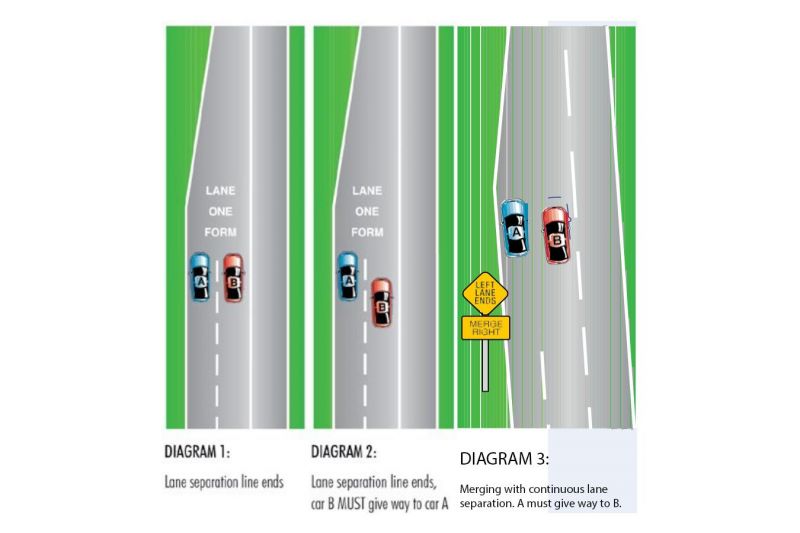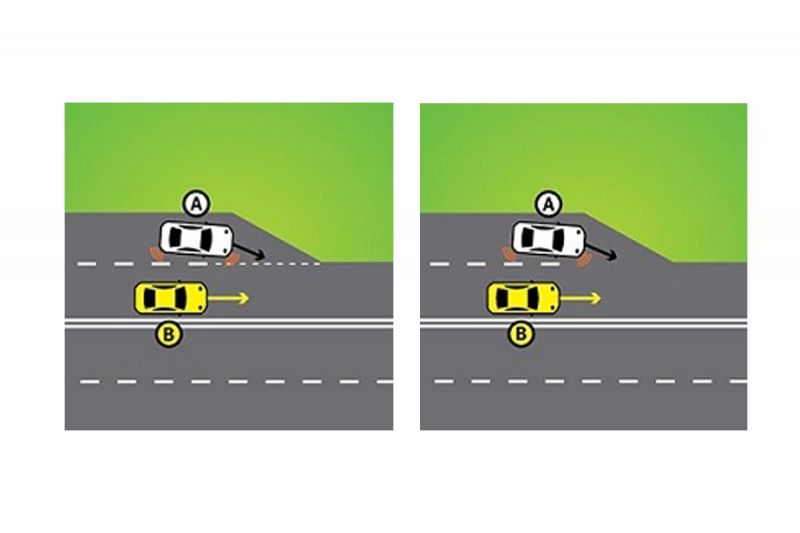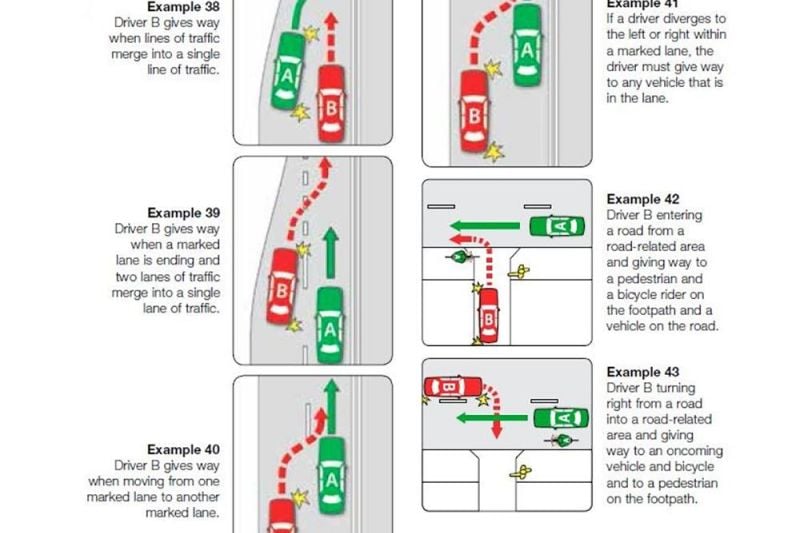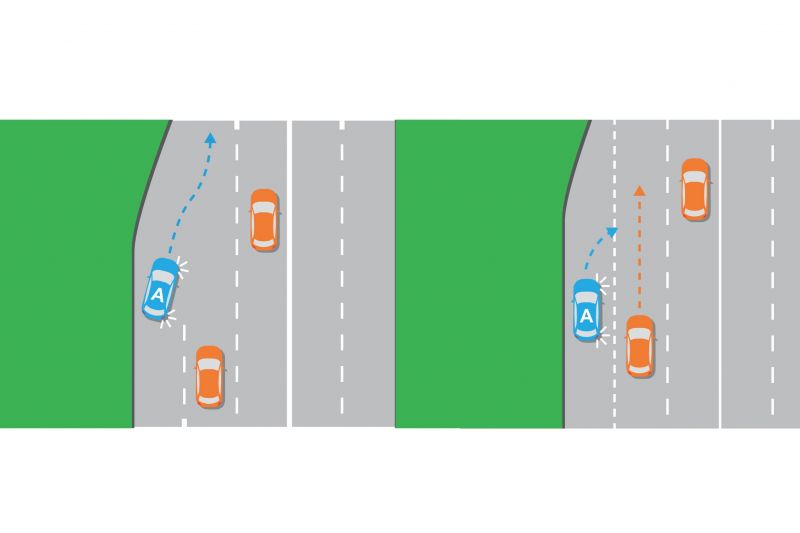Some individuals see indicating when merging as a typical courtesy — letting different street customers know that you just’re planning to maneuver throughout is an easy and good factor to do.
- Merging is one thing lots of people do mistaken
- In some states you should point out when merging
- There are various kinds of merging with completely different guidelines in numerous jurisdictions!
In idea it needs to be easy. Some newer automobiles have indicator stalks which can be unnecessarily sophisticated to cancel whenever you attempt to merge… nevertheless it needs to be a bit of cake.
Nevertheless, do you know you may be fined, and even be penalised with demerit factors, for not indicating when merging? And are you aware what the damaged traces signify whenever you’re merging?
In NSW, the foundations round altering lanes state {that a} driver “should give solution to automobiles within the lane you’re shifting into”, and additional, that in the event you’re trying to maneuver into one other lane, “you should point out to let others know” and “ensure that your indicator is off after you’ve merged or modified lanes”.
“When the lane you’re driving in is ending and you must cross a damaged line to maneuver into one other lane, you should give solution to automobiles already in that lane – for instance, whenever you’re becoming a member of a motorway.” See illustration under:
NSW Transport states: When a automobile is crossing a damaged line to alter into one other lane (Automotive A), it should give solution to automobiles already in that lane (Automotive B).
Most of us most likely thought that the rule can be “whoever is in entrance will get to go”, and that appears to be the behaviour that performs out on roads round Australia. However the onus is on the merging automobile to make sure it’s protected to take action.
Should you try and make the transfer with out indicating, you may be fined $227 and hit with two demerit factors.
Nevertheless, the distinction between that state of affairs and an precise ‘merge’ is the road markings on the street.
This instance from NSW Transport helps present what the important thing distinction is:
NSW Transport states: When two lanes scale back to 1 lane, the automobile trailing behind (Automotive B) should give solution to the automobile forward (Automotive A).
“If you’re driving on a street and the variety of lanes or traces of site visitors reduces, and there are now not any street markings, you should give solution to the car that’s forward of you. That is known as a zipper merge,” in line with the state’s transport legal guidelines.
Word that there are not any indicators required for this kind of merge.
The foundations are the identical within the Northern Territory, with barely completely different wording:
“If the road ends earlier than the lanes merge, the car behind should give solution to the car in entrance. When the lane ends and you must cross the traces to merge, you should give approach.”
The high-quality for “fail to sign turns, change lane, cease” is $60 within the NT.
The Australian Capital Territory has a barely completely different tackle issues, with a hardline method to merging with its
“type one lane” street markings:
“A and B should each be ready to present approach or each could also be charged following a collision.”
DIAGRAM 1: Generally the lane separation line will finish and each lanes of site visitors are required to merge into one lane. When merging in such instances, the car that’s forward has the fitting of approach over the trailing car.
DIAGRAM 2: You need to use care, commonsense and courtesy when merging.
Additional, there are conditions the place the marked line continues (diagram 3), and in that occasion: “Lane altering procedures are required when one lane ends and you’re required to merge into one other lane. This consists of utilizing your mirrors, indicators and doing a head examine. If you must cross a lane line, or merge line, you MUST give solution to any automobiles within the lane that you just want to enter. You will need to not cross until it’s protected to take action.”
The penalty for failing to sign appropriately within the ACT is $326 and two demerit factors.
In Victoria, the foundations are barely completely different.
VicRoads states:
- Everytime you change lanes from one marked lane to a different, you should give solution to automobiles already in that lane, or line of site visitors. This consists of merging in freeway site visitors. Point out and alter lanes when there’s a protected hole.
- If the lane in entrance of you is blocked, you should point out and provides approach.
- Zip merging is the place two lanes of site visitors merge into one, on a street the place there are not any lane markings. You will need to give solution to any car which has any a part of its car forward of yours.
- You aren’t zip merging in the event you cross any traces marked on the street. Should you do cross traces marked on the street you should observe the give approach guidelines for altering lanes.
Apparently, VicRoads illustrates that even in zip merge conditions, the driving force forward should point out. Should you “fail to present sign”, you may be fined $198 and cop two demerit factors.
Queensland follows the identical mindset as Victoria, with the state’s transport authority positing that each one drivers should point out when merging, whether or not there are lane-markings or not.
- On roads the place there are lanes marked on the street—in case your lane involves an finish, you should give solution to site visitors already within the lane you’re shifting to. On this instance, Automobile A (white) should give solution to Automobile B (yellow).
- On roads the place there are not any lanes marked on the street—when traces of site visitors merge, you should give solution to any car that’s forward of you. On this instance, Automobile B (yellow) should give solution to Automobile A (white).
Failure to sign accurately in Queensland might internet you a $96 high-quality and two demerits.
In South Australia:
- Drivers should give solution to a car in your left or proper if any a part of that car is forward of your car.That is known as the Zip Merge (Instance 38).
- The Zip Merge doesn’t apply the place lane traces are marked between the automobiles and one lane is ending (Instance 39) reminiscent of on the finish of overtaking lanes and when getting into the freeway.”
- In case you are driving on a multi-lane street and wish to transfer into one other lane of site visitors, both to your proper or left, you should first examine that it’s protected to alter lanes, give a change of route sign clearly for lengthy sufficient to warn different street customers, and provides solution to site visitors within the different lane (Examples 39 and 40). This additionally applies to bike lanes and the place the street is broad sufficient for 2 traces of site visitors however there are not any lanes marked on the street (Instance 41).
South Australian police might implement a 3 demerit level, $502 penalty for “fail to present approach when altering lanes”.
Tasmania police will hit you with two demerits and a $146 high-quality for failing to sign, and you may cop that high-quality in both of the next conditions:
- Merging when the variety of lanes is lowered: In case you are travelling on a street with out lane markings and the variety of lanes or traces of site visitors is lowered, you should merge by giving solution to any car that’s forward of you. That is typically known as a zipper merge.
- Altering lanes when a marked lane ends: In case you are travelling in a marked lane which is ending and you’re required to cross a damaged white line to enter the adjoining lane, you should give solution to any site visitors travelling within the lane being entered.
Western Australia:
- The place two lanes merge into one – that’s the place the lane line ends – the car in entrance has proper of approach. When merging, match the authorized velocity of the lane you’re shifting into, hold a protected distance between you and the car in entrance of you, and in lengthy traces of merging site visitors, take turns to merge.
- If there are twin lanes, and the lane you’re in ends, give solution to the automobiles within the lane shifting into.
WA Transport reminds motorists to “at all times use your indicator to sign your intentions to different drivers when merging”. The state could impose fines and demerit factors, with fascinating wording for the offences: Failing to present approach when merging (two demerit factors, $100); Failing to present approach when altering lanes (three factors, $100).
It’s at all times advisable to concentrate on the legal guidelines and rules relevant to the jurisdiction that you just reside in.
Not supposed as authorized recommendation. Verify with the related roads authority in your state or territory.





